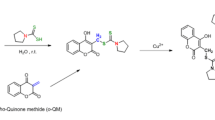Abstract
Benzyloxybenzaldehydethiosemicarbazone (BBTSC) was prepared and developed a new method for the simple, highly selective, and extractive spectrophotometric determination of copper(II) with BBTSC at wavelength 370 nm. The metal ion formed a bluish green colored complex with BBTSC in acetate buffer of pH 5.0, which was easily extractable into n-butanol with 1:1(metal/ligand) composition. The method obeys Beer’s law in the range of 0.5–5.2 ppm. The molar absorptivity and Sandell’s sensitivity were found to be 1.5 × 104 l mol−1 cm−1 and 0.00412 g cm−2, respectively. The correlation coefficient of the Cu(II)–BBTSC complex was 0.998, which indicated an excellent linearity between the two variables. The repeatability of the method was checked by finding the relative standard deviation (RSD; n = 10), which was 0.377% and its detection limit 0.0204 μg ml−1. The interfering effect of various cations and anions were also studied. The proposed method was successfully applied to the determination of copper(II) in food and water samples. Comparing the results with those obtained using an atomic absorption spectrophotometer tested the validity of the method.





Similar content being viewed by others
References
Desai JM, Desai KK (1999) Asian J Chem 11:1311–1316
Eichhorn GL (1975) Inorganic biochemistry. Elsevier Scientific Publishing Company, New York
Edwards M, Schock MR, Meyer TE (1996) Alkalinity, pH and copper corrosion by-product release. J Am Water Works Assoc 88:81–94
Harris ED (1983) In: “trace elements in health”. Butterworth, London
Hemanth Kumar MS, Nagaraja P, Yathirajan HS (2003) Anal Bioanal Chem 375:315
Jadhav VA, Vandre AG (1995) J Indian Chem Soc 72:747–748
Kocharekar A, Achana R, Takkar NV (2004) J Sci Ind Res 63(3):283–286
Khasnis DV, Shinde VM (1982) J Indian Chem Soc 59(6):812–814
Khasnis DV, Shinde VM (1984) J Indian Chem Soc 61:275–277
Kudapali YS, Suresh J (2004) Orient J Chem 20(2):313–316
Lakshmi Narayana S, Janardhan Reddy K, Adinarayana Reddy S, Rajesh Kumar J, Varada Reddy A (2007) J Chin Chem Soc 54:1233–1241
Lokande RS, Jaywant AS (1999) Asian J Chem 11(3):1040–1042
Lokande RS, Nirupa S, Chaudhary AB (2002) Asian J Chem 14(1):149–152
Lokhande RS, Poman SV, Kapadi HR (2001) Asian J Chem 13:1222–1224
Lopez-de-Alba P, Lopez-Martinez L, Amador-Hernandez J (1999) Bol Soc Chil Quim 44:469–477
Ma T, Liu M, Hu C, Liu K, Liu Z (1999) Ziran Kexueban 31:70–72
National Research Council (1980) Copper. In: Recommended dietary allowances. Food Nutrition Board, NRC/NAS, Washington, DC, pp 151–154
Patel AL, Patel IJ (2000) J Inst Chem (Indian) 72:8
Ramesh A (2001) Ph.D. Thesis, S.V. University, Tirupati. 104
Reddy KH, Chandrasekhar KB (2001) Indian J Chem 40(7):732
Solomons NW (1985) J Am Coll Nutr 4:83–105
Sorenson RJR (1987) Biology of copper complexes. Humana, Clifton, NJ
Sorenson RJR (1989a) Prog Med Chem 26:507
Sorenson RJR (1989b) Prog Med Chem 26:437–568
Tongsen M, Meng L, Longde H, Kacizhi L, Zhenghao L, Daxuesuebao Z (1999) Ziaru Keruebau 31:70–72
Vogel AI (1961) A text book of quantitative inorganic analysis. Longman, London, UK
Zacarias I, Yanez CG, Araya M, Oraka C, Olivares M, Uauy R (2001) Determination of the taste threshold of copper in water. Chem Senses 26:85–89
World Health Organization (1998) Guidelines for drinking water quality, 2nd edn (addendum to vol. 2. health criteria and other supporting information). World Health Organization, Geneva, Switzerland
Acknowledgments
One of the authors, K. Janardhan Reddy, is highly grateful to the Council of Scientific & Industrial Research (CSIR), Government of India, New Delhi for financial assistance in the form of Senior Research Fellowship.
Author information
Authors and Affiliations
Corresponding author
Rights and permissions
About this article
Cite this article
Narayana, S.L., Reddy, K.J., Reddy, S.A. et al. Benzyloxybenzaldehydethiosemicarbazone: Extractive Spectrophotometric Reagent for the Determination of Cu(II) in Food and Water Samples. Food Anal. Methods 1, 293–299 (2008). https://doi.org/10.1007/s12161-008-9028-1
Received:
Accepted:
Published:
Issue Date:
DOI: https://doi.org/10.1007/s12161-008-9028-1




